Taking your first flight with a toddler might feel like an overwhelming challenge. Do not fret: I know from personal experience that a little preparation and the right mindset make all the difference. I have taken one or two toddlers in dozens of flights – both with a partner and as a solo parent. If I can do it, so can you!
In this post, I’ll break down how to handle flying with a child between the ages 1 and 3 years old. You know, that stage when they’re walking, exploring, and asserting their independence but also cannot reason or pay attention. While I cannot promise you a stress-free flight, I will share many tips to get you and your toddler through this adventure.


1. Before the Flight
Preparing Your Toddler
Toddlers handle new experiences so much better when they know what’s coming. So, before your toddler’s big first flight, take some time to explain the whole airport and airplane experience. Do this at least a few times and over a few days. Read books, watch videos, and talk through what will happen. Bonus points if you can take a trip to the airport in advance to help them get familiar with the environment. Even seeing the planes taking off can be exciting for them!
Preparing Yourself
Your mindset is key. Remind yourself of why you are traveling with your child. Family travel is hard, but also important – and it benefits your child in so many ways. You can read some research-based reasons to travel as a family here.
Besides knowing what to pack and what to do before, during, and after the flight (more on that below), it’s equally important to get your head in the right space. Here are a few truths to help you through the day:
- Toddlers have good and bad days, just like adults – and that is OK.
- You’re not a bad parent if your toddler melts down mid-flight.
- You and your toddler have the right to travel, even if you’re having a tough time.
- Your priority is your toddler’s well-being, not the opinions of other passengers.
In my experience, most people are mostly kind and understanding. You may feel like all eyes are on you, but trust me—the good far outweighs the bad.




2. What to Pack
When packing, you should weight the convenience an item provides against the effort it will take to carry and manage it. Some decisions are very unique to your toddler and your family. Below are some things that I consider essential for your first flight with a toddler. I also listed some optional items – these can be tricky and you might make different choices depending on the circumstance.
Essential: Toddler-Friendly Food and Drinks
Snacks, snacks, and more snacks: Pack their favorite foods (nutritious snacks and yummy treats) plus extras in case of travel delays. I like to bring several small containers that I hand to my toddler one at a time. I learned this lesson the hard way after my toddler dumped all the snacks on the ground at once.
Leakproof water bottle: Emphasis on leakproof! You do not want water spilled all over your bags, the seat, or your toddler. A quick tip: be careful with bottles that have straws. The air pressure builds inside during takeoff and water might shoot out of the straw when you finally open it. That water might go far enough to hit the passengers around you (ask me how I know that!).

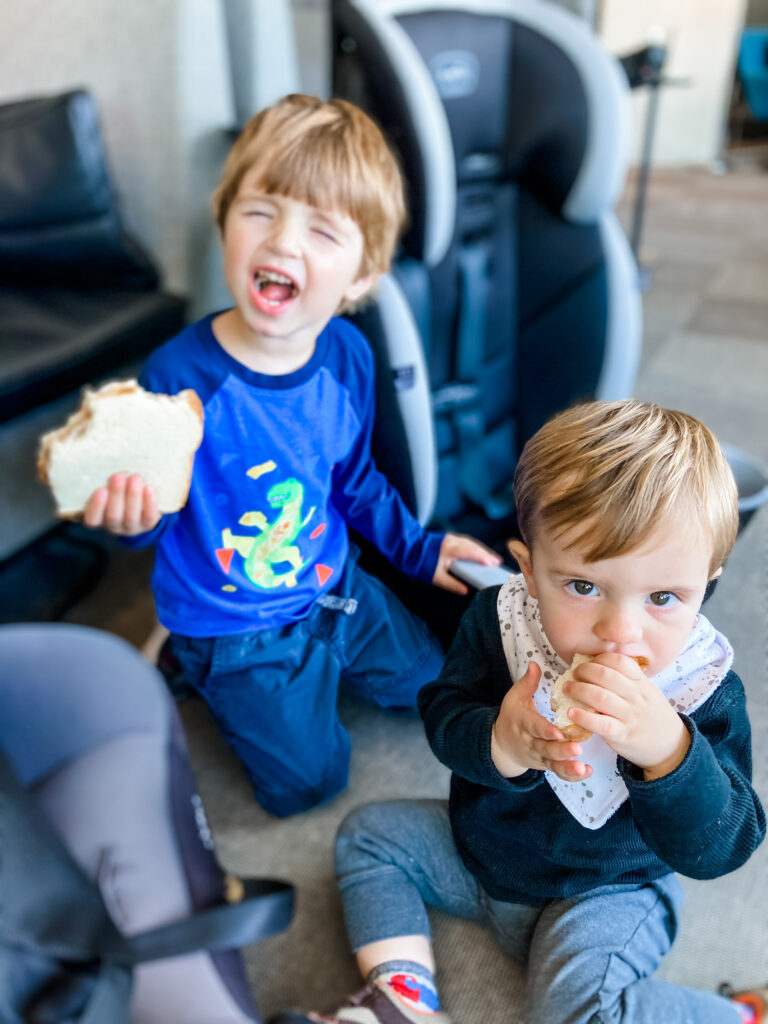
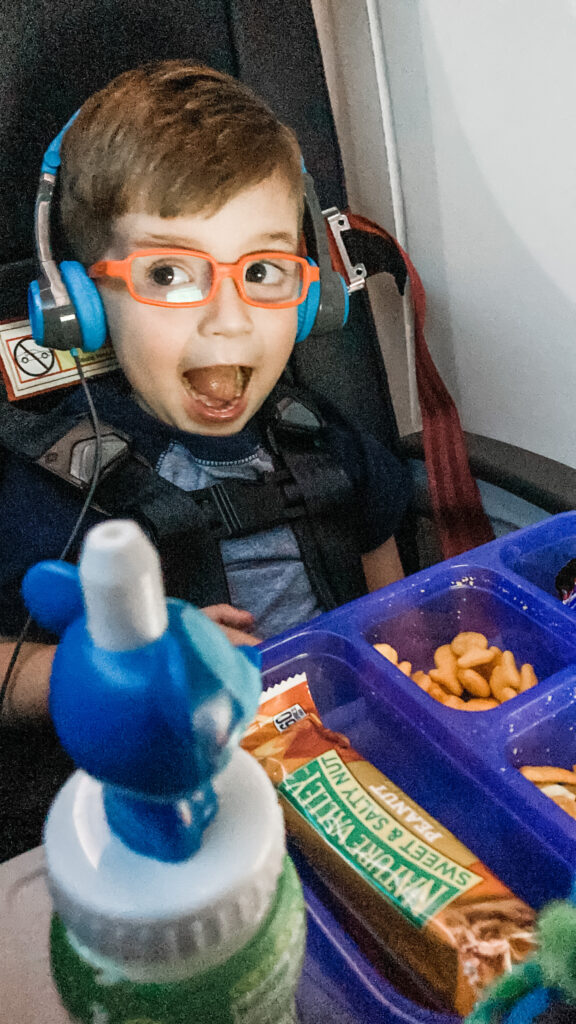
Essential: Dress Your Toddler for Success
Diapers and wipes: Bring one diaper for every two hours of travel time, plus a couple extras just in case. As for wipes, a medium-sized pack should do the trick. Fun fact: sometimes airport security wants to inspect baby wipes, so keep them somewhere easily accessible. Because airplane bathrooms are tiny, you might want to practice a standing diaper change—it’ll make your life easier. For toddlers potty training, consider using pull-ups for peace of mind during the flight.
Extra outfits: Bring one complete outfit for each of you. Messes happen, and you don’t want to be caught without a backup. A wet bag for dirty clothes is also a good idea – we have these and they have lasted us 5+ years!
Warm layers: Airplanes can get chilly – make sure you have some warm layers or a blanket for your toddler to keep them comfortable.
Essential: Toddler Mid-Flight Entertainment
While entertainment IS essential to keep your toddler content during the flight, bringing all the things IS NOT necessary. Pack only what will bring you and your child the most benefit through your flight.
- Toys: Keep it simple. Toddlers can be just as entertained by a plastic cup as they are by actual toys. If you do bring a few toys, make sure they are small, lightweight, quiet, and can hold your kid’s attention. Use the novelty effect, either by getting a few new toys or bringing out some old favorites. Here are some toys our children have enjoyed:
- Suction Cup Spinner Toys: these are the best for younger toddlers.
- Fidget Toys (for older toddlers): we have loved spinners, monkey noodles, and pop tubes!
- No-Mess Crafts: Wiki Stix, sticker books, Water Wow Books.
- Games: this magnetic puzzle will keep pieces from going everywhere, and so will this memory game.
- Magnetic Toys: These are meant for kids aged 3+ but we started enjoying them earlier with careful monitoring. They are some of my kids’ favorites – especially these and these.
- Books: Only bring books if your toddler loves them. My kids lose interest quickly, and books tend to be bulky. If you do bring some, stick with light paperbacks over heavy board books.
- Electronics: If your family limits screen time, that’s totally fine! However, a tablet loaded with shows and games or a Yoto player with some favorite cards can be a lifesaver, especially for older toddlers. Plus, if your toddler has limited access to screens at home they will be MUCH more enticing during your flight. Just don’t forget the headphones (and practice using them before the flight!).
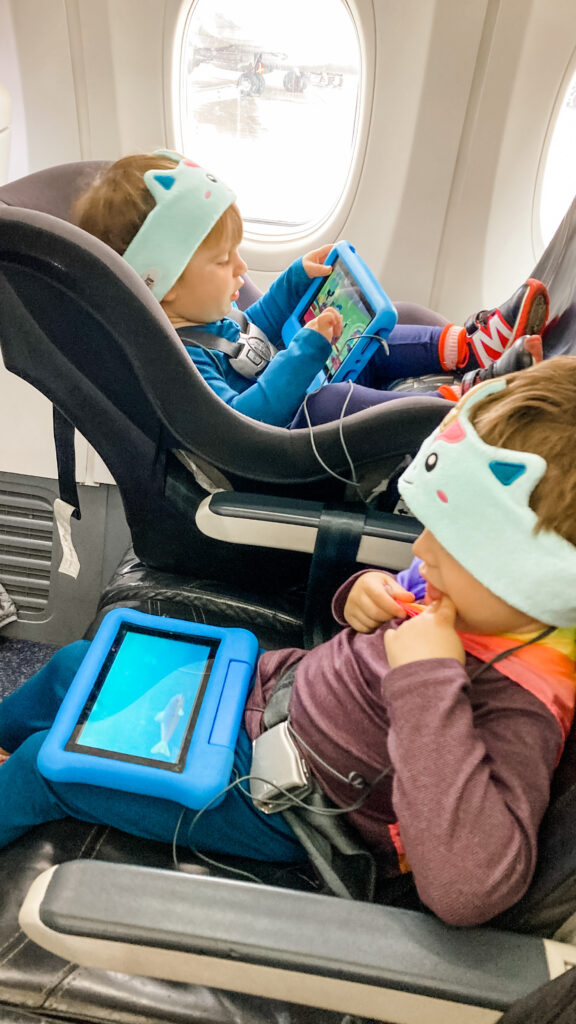

Tricky Travel Decisions: Strollers, Car Seats, and Baby Carriers
How you transport your toddler through the airport is a very important consideration. You are not alone if you are agonizing over this ahead of your flight. Unfortunately, you the only one who can decide what will work best for your family. Deciding whether to bring strollers, car seats, and baby carriers with you can be tricky, so let’s break it down.
Stroller: Bring It or Leave It?
At first glance, you might think a stroller is a no-brainer, but I’d say it’s more of a strong maybe. While it can be a lifesaver in some situations, it can also become just another thing to lug around. Here’s a quick breakdown of the pros and cons:
Biggest Pros
- Helps with Transporting Your Toddler: A stroller can easily get your toddler from point A to point B, especially if they’re the type who gets tired of walking. It will be especially helpful if your toddler can nap on it.
- Storage: Some strollers might offer extra space to stash your carry-on items or personal belongings, freeing up your hands.
Biggest Cons
- Your Toddler May Refuse to Sit in It: The best-laid plans can go out the window when your independent toddler decides they need to walk everywhere. If this happens, you’ll be stuck pushing an empty stroller.
- One More Thing to Manage: Most strollers that are compact enough to be brought onto an airplane can be flimsy and don’t offer much storage. Sturdy strollers are often bulky and can be a hassle to fold up, carry, and stow away. Plus, there’s always the risk of it getting damaged during transport, costing you money and adding to your stress.
- Limited Usefulness in Airports: If if your flight requires lots of quick connections or airport changes, managing a stroller along with luggage and a toddler can quickly become overwhelming.
Ultimately, if you’re a heavy stroller user in your day-to-day life and you know it’ll be helpful during your trip, bring it! Some parents swear by their travel strollers, especially if they’re lightweight and easy to fold. Others swear by their sturdy jogging strollers and their ability to carry everything. On the flip side, if your family uses strollers sporadically, you might be better off leaving it home.



Car Seats: The Big Question
Deciding whether to bring a car seat on your trip is one of the toughest decisions when flying with a toddler. There are several factors to consider, and it really comes down to your family’s travel style and destination. Here’s a quick overview of the key points you should think about.
Things to Consider if You’re On the Fence:
- Will You Need a Car Seat at Your Destination? If you’re renting a car or will be driving around a lot, you’ll need a car seat. If you’re relying on public transportation you might be able to skip it. While some destinations may have lenient rules for ride-shares or taxis, the safety of your kids should always be a priority.
- How Will You Get a Car Seat if You Need One? One option is to bring your own, but you may also rent (from a car rental company or a baby gear rental company), borrow from friends or family members, or even purchase an affordable seat at your destination.
- Do You Want to Bring It on the Plane? While the FAA recommends using car seats for toddlers onboard for safety reasons, you don’t have to. Some parents opt to check their car seat as luggage or at the boarding gate, though that does come with the risk of loss or damage. If you decide to use it onboard, make sure it’s FAA-approved.
- How Will You Transport the Car Seat? If you’re bringing the car seat onboard, you’ll need to figure out how to carry it through the airport. Consider a lightweight and affordable car seat that may be easier to handle during your trip. Some parents use a car seat travel cart, strap it to their luggage or strollers, or use car seat backpacks.
Why Bring Your Own Car Seats:
- Cost Savings: Renting car seats from rental car companies or ride-shares can add up, and you might not always get a seat that’s the right size. By bringing our own, you can save money and avoid the uncertainty.
- Cleanliness & Safety: You can trust the cleanliness and safety of your own seats. Car seats that belong to rental agencies may look clean, but there’s always a risk of wear and tear.
- Familiarity: You know how to install your car seats quickly and correctly. There’s nothing worse than fumbling with a rental car seat when your toddler is melting down.
- Comfort for the Kids: Your toddler knows their car seat and feels some level of comfort in it, which can be helpful when going through a new experience.
Why Bring Your Car Seats on the Plane:
- Better Containment: On the plane, a car seat keeps your kids securely buckled and less squirmy, which can makes the flight more manageable.
- Improved Sleep: Kids are used to their car and are more likely to sleep on them than on an uncomfortable airplane seat.
- Less Risk of Loss or Damage: Car seats checked with luggage can get lost or damaged. While most airlines will offer you an alternative car seat if they damage or lose yours, it will add to your stress and delay your trip.
What works for our family? While bringing a car seat can feel like a hassle, I personally think it is worth it for the peace of mind it brings me—both in terms of safety and comfort. We own travel-specific car seats that we have taken on dozens of flights. They are affordable, lightweight, and easy to use – we like this one for younger toddlers and this one for older ones. We strap them to this travel cart, which unfortunately has been discontinued, but there are similar ones in the market.
What works best for us may not work for every family. My advice is to think carefully through your travel plans and decide what will make your trip easier. In the end, there’s no right or wrong answer here—just what works best for you and your toddler.


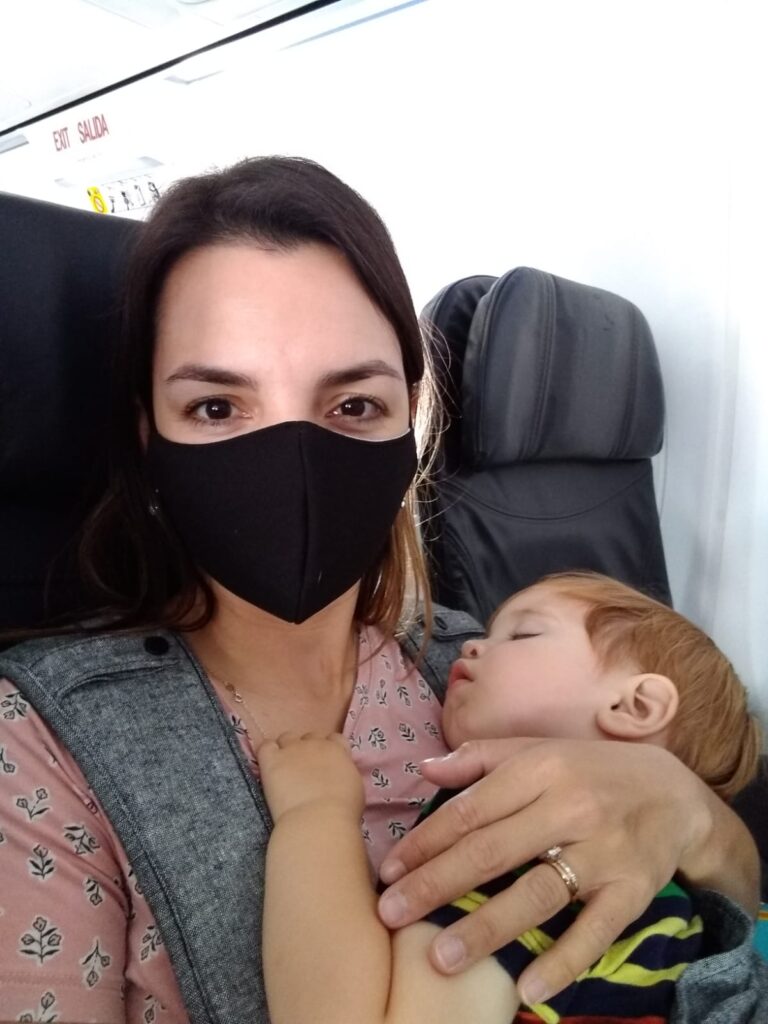
Baby Carrier: Do Toddlers Need Them?
While baby carriers are not as essential with a toddler as they can be with a baby, a carrier may be helpful if your toddler enjoys it. Personally, we relied on baby carriers much more often than strollers. It is one of our primary ways of moving our kids through busy airports, security lines, and tourist destinations. Our carrier has also been key when little ones got tired, anxious, or needed a break.
If your family relies on baby carriers in daily life, bring them. If not, feel free to leave them!
3. At the Airport
Give yourself plenty of time to navigate the process and do your best not to rush. Toddlers like to move at their own pace, and hurrying will only add to everyone’s stress. Here are some tips:
- Arrive early: we like to arrive 2 hours before a domestic flight and 3 before an international one.
- Check as much luggage as possible: Even if you’re usually a fan of carry-on-only travel, freeing up your hands when you’re wrangling a toddler is worth it.
- Let them explore: Once through security, allow your toddler to burn off some energy. Many airports have play areas, but even simple things like escalators or big windows can be entertaining.
- Potty and snack break: Before boarding, take one last bathroom break and offer a snack. This will reduce the chances of needing to rush through the aisles mid-flight.
- Gate check any items you need to: if you have a stroller or car seat to gate check, you will want to do that before boarding starts. If you are bringing your car seat into the plane, the boarding agent will also want to inspect it ahead of time.



When Should You Board the Plane With Your Toddler?
There are a few lines of thought here, and no wrong answers.
- The Early Bird: Sometimes it makes sense to take advantage of the family early boarding option so you can get into the plane and get settled before everyone else comes in. It does, however, come with the predicament of what to do with a fidgety toddler while everybody else boards.
- The Last Call: Sometimes it makes sense to let your toddler use up as much of their energy before the flight by boarding last. The downside is that you might feel pressured to hurry up and you may struggle to find overhead storage near your seat.
- The Tag Team: A third option is to have one person board early and get settled while the other lets the little one play. This gives you the best of both worlds – if you are traveling with a partner.
Choose whichever option suits you best. You will likely choose differently each time depending on the circumstances.



4. On the Plane
Now comes the hard part. Toddlers can be unpredictable inside airplanes, but there are ways to make it manageable:
- Keep them entertained as best you can: This is where your snacks, toys, and electronics come in handy. Don’t expect downtime for yourself—toddlers need constant engagement at this stage. It helps to let the novelty of an item completely wear out before handing them a new toy/snack/book.
- Prepare for meltdowns: If your toddler loses it mid-flight, take a deep breath and remind yourself that it’s okay. Airplanes are so loud, it is possible most people are not even listening. The flight is just a small part of your journey, and you’ll be at your destination soon enough.
- Accept help: There are more people willing to help a parent with a small child than you might think. Flight attendants tend to be very gracious. Other moms or grandmas in the same flight may also be more than willing to help – if you will only let them step in.
Fly Your Toddler as a Lap Baby or Get Them a Seat?
When flying with a toddler under 2 years old, one big decision is whether to have them as a lap baby or get them their own seat. Here’s some considerations to help you decide what to do:
Lap Baby
Pros:
- Cost-effective: No extra ticket needed, except for some international fees.
- Preference: Some toddlers prefer your lap anyway, avoiding wasted money on a seat they won’t use.
- Contact naps: Easier to make happen if your toddler is used to napping on you.
- Baby carrier option: Frees up your hands (except during takeoff/landing).
Cons:
- Limited space: As your toddler grows, sharing a seat can become uncomfortable.
- Sleep difficulties: Toddlers not used to contact napping might struggle to sleep.
- Tiring: Managing a squirmy toddler on long flights can be exhausting.
Toddler on Their Own Seat
Pros:
- More space for everyone: Extra room for you to spread out or for your toddler to play.
- Safety: You can use a car seat, keeping them secure during turbulence. Make sure you book a window seat for your toddler if you plan to use a car seat!
- Better sleep: Familiar sleeping environment for toddlers used to sleeping on car seats.
- Movement: Allows them to better stretch and stand during the flight.
Cons:
- Cost: You’ll very likely pay for a full ticket, which adds up quickly. Check if the airline offers any discounts!
- Seat refusal: Some toddlers may prefer your lap, even if you’ve bought a seat for them.
In the end, it depends on your toddler’s temperament, comfort, and your budget. Choose what works best for your family!

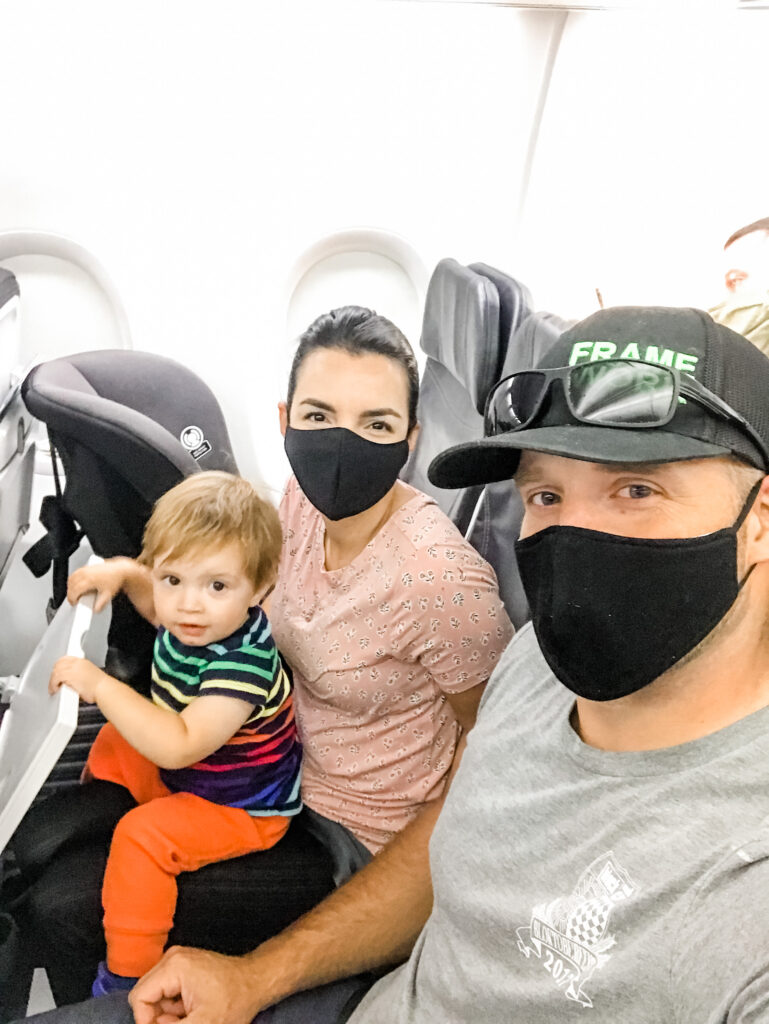
Final Thoughts
You made it! Whether the flight was smooth or bumpy, you’ve arrived. Toddlers get overstimulated pretty easily, so give them some downtime once you reach your destination. I usually plan a quiet first day to help everyone adjust and recover.
Your first flight with a toddler will likely be memorable, if not for the actual flight, then for the adventures awaiting you on the other side. Traveling with young children is never easy, but with preparation, flexibility, and a positive mindset, you’ll make it through—and maybe even enjoy it!
Read More:
- Hiking With a Toddler: Starting Small and Loving the Journey
- How to Dress Kids in Winter: Keeping Your Little Ones Warm in Alaska (or Anywhere Else!)
- Baby Hiking Gear to Simplify Your Adventures
- Can You Hike with a Baby? Absolutely! Here’s How I Did It in Alaska.
- What to Take Hiking With a Toddler: Essential Gear and Tips

